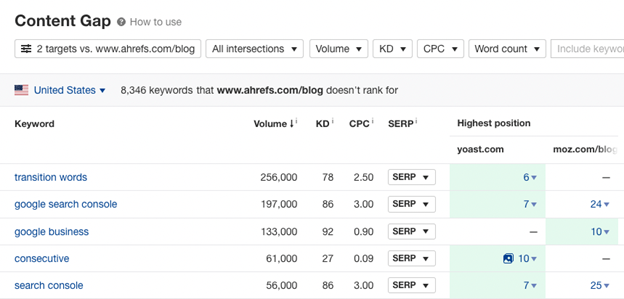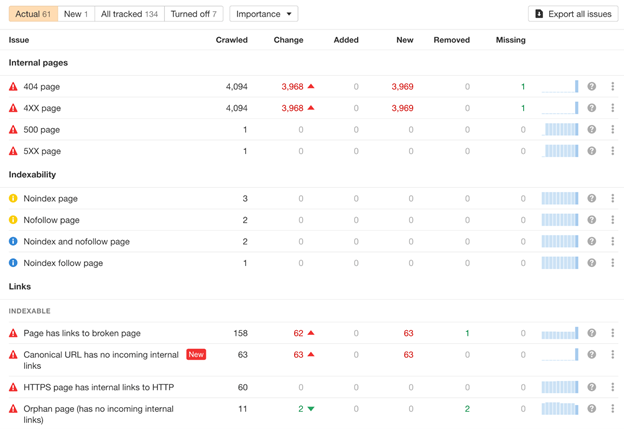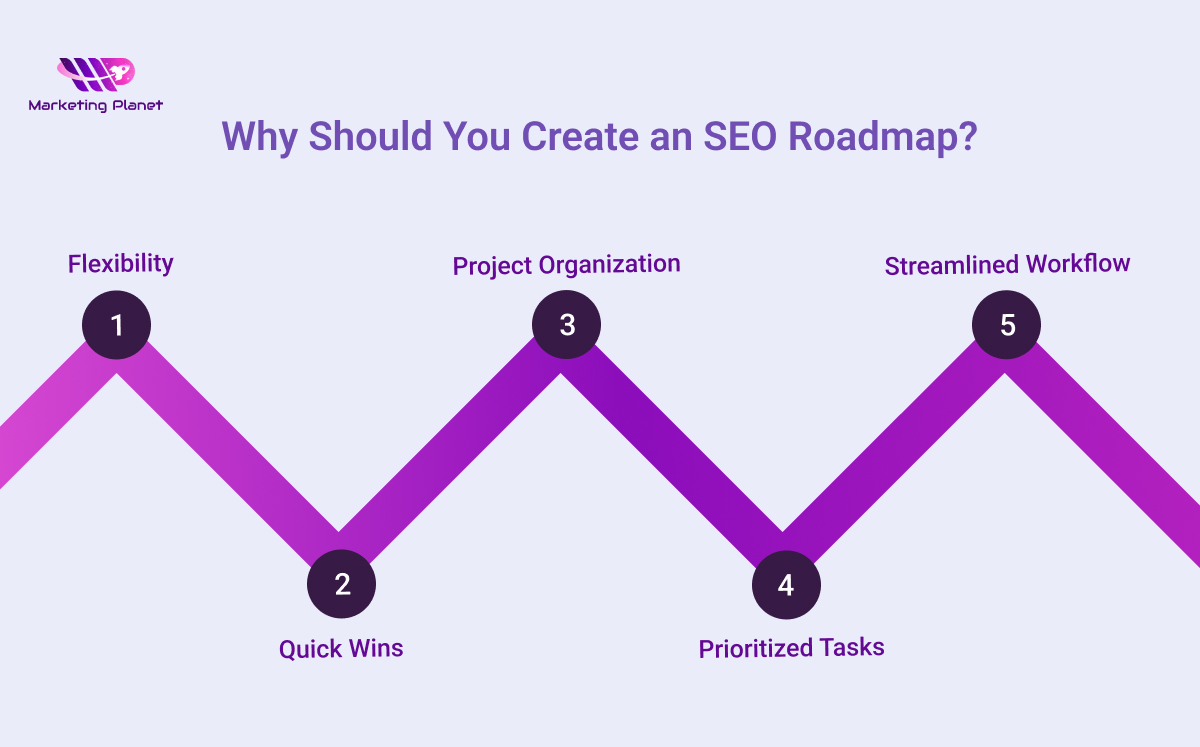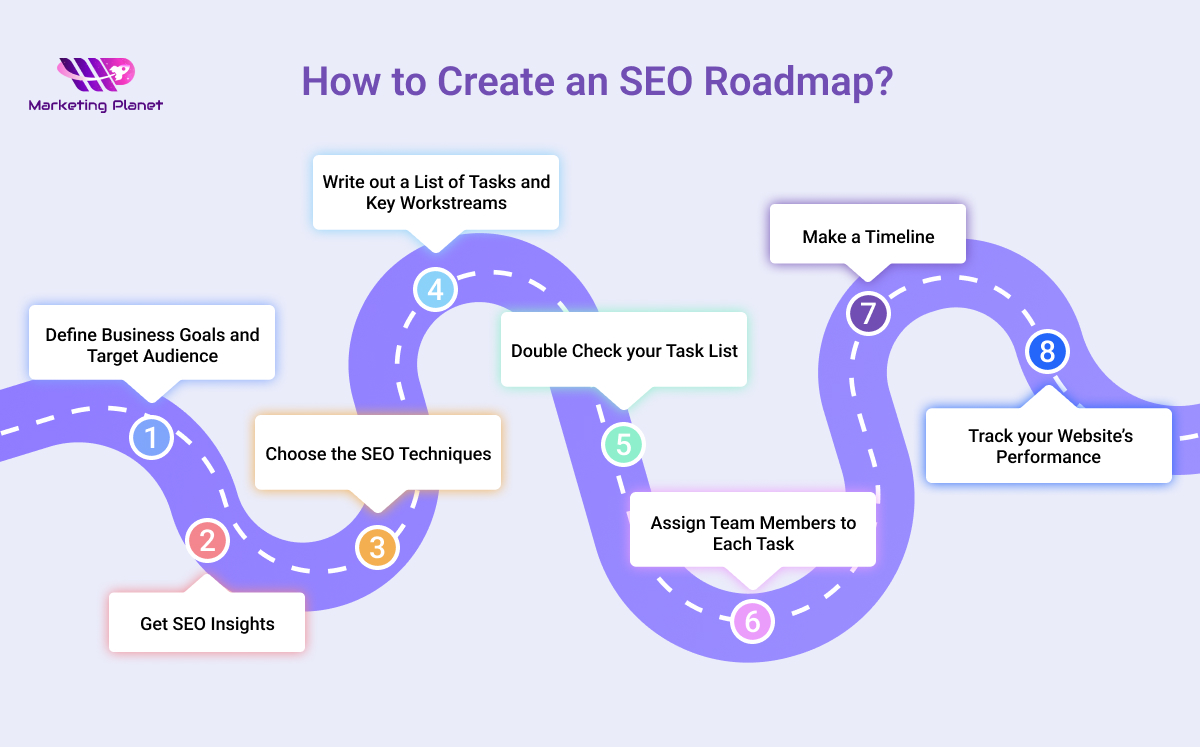The SEO roadmap is a crucial document in an SEO campaign, formalizing the strategy and serving as a tracker for executing SEO tasks.
Table of Contents
ToggleFeeling overwhelmed by the ever-changing world of SEO? You’re not alone. Ranking well on search engines requires a strategic plan, and that’s where an SEO roadmap comes in.
In this blog post, we’ll guide you through the process of building an SEO roadmap that will take your website from a hidden gem to an SEO powerhouse.
We’ll cover everything from setting goals to prioritizing tasks, ensuring you have a clear path to achieving top search engine results. So, grab your compass and get ready to navigate the SEO jungle with confidence!
What Is an SEO Roadmap?
An SEO roadmap is a detailed plan of action that outlines the crucial tasks to be completed during an SEO campaign. It includes workflows, a project timeline, due dates, and the individuals responsible for each task.
This roadmap is a strategic plan that formalizes and tracks key tasks within an SEO campaign, typically created within the first three months and typically spanning six to 12 months.
It is a “living” document that requires updates and amendments as the SEO strategy evolves over time.
Why Should You Create an SEO Roadmap?
An SEO roadmap acts as a blueprint for your website’s journey towards ranking higher in search results. Here’s why you should strongly consider creating one:
1- Flexibility
An SEO roadmap is essential for SEO teams to adapt to changing guidelines and customer needs, enabling them to quickly pivot and continue achieving their goals by making tasks, deliverables, and methodologies more fluid.
2- Quick Wins
A quick win is a strategy where minor changes can improve traffic and rankings. An SEO team can tackle quick wins with minimal resources, such as fixing title tags or speeding up hosting.
An SEO roadmap helps identify opportunities for quick wins, ensuring no missed opportunities and overall improvement in SEO strategy.
3- Project Organization
An SEO roadmap is crucial for managing large projects and maintaining organization, as it helps prevent slipping through the cracks due to the numerous people involved and different tasks.
4- Prioritized Tasks
SEO encompasses various aspects, and a roadmap helps prioritize tasks based on their potential impact. This ensures you focus on high-impact areas first, maximizing your return on effort.
5- Streamlined Workflow
The roadmap defines the workflow for each SEO initiative, outlining responsibilities and standard procedures. This streamlines the process and avoids confusion or wasted efforts.
How to Create an SEO Roadmap?
Creating an SEO action plan is the best approach to enhance search engine rankings and drive website traffic. Here’s how to create an SEO roadmap in 2024:
1- Define Business Goals and Target Audience
Identify your primary objectives. Are you aiming to increase brand awareness, generate leads, or boost sales? Quantify these goals with specific metrics like website traffic, conversion rates, or desired ranking positions for relevant keywords.
Understanding your ideal customer is essential. Research their demographics, interests, and online behavior. This knowledge will guide your keyword research and content creation strategies.
2- Get SEO Insights
To create a successful SEO campaign, start with thorough keyword research to understand content gaps and low-hanging fruit opportunities.
A keyword gap analysis can help determine the appropriate time spent on content, ranging from fresh content opportunities to existing content re-optimization. Use Ahrefs’ Content Gap tool to form a keyword gap analysis and find missed keywords.

For technical tasks, use Ahrefs’ Technical SEO audit to identify key actions and technical errors. If you run regular site crawls, refresh yourself on key issues to address in your roadmap. Technical errors can be found in Ahrefs’ Site Audit.

Depending on your approach to link building and team structure, list out tasks related to this. The Overview report in Ahrefs’ Site Explorer is a great starting point for understanding your backlink profile.
Note down key metrics such as Domain Rating (DR), URL Rating (UR), total backlinks, and referring domains. Comparing your backlink history vs. your competition via the “Performance” graph is also useful for understanding the rate at which backlinks have been acquired.
3- Choose the SEO Techniques
To achieve your business goals, choose the right SEO techniques. These include local SEO, keyword implementation, SEO content creation, link building, voice search optimization, mobile-friendly optimizations, user experience optimizations, and page speed improvements.
For instance, a local SEO strategy can drive foot traffic to your physical store location, while an SEO content strategy can increase brand awareness and website traffic.
These strategies can help you rank at the top of search results when your target audience needs answers and solutions.
4- Write out a List of Tasks and Key Workstreams
To begin your strategy, create a roadmap of tasks and key workstreams for the next 12 months. Keep in mind that not every detail will be covered, so focus on key workstreams and overarching tasks.
Crafting a well-defined list of tasks and key workstreams is crucial for building an effective SEO roadmap. Here’s a breakdown of the process:
#1 Preparation
Before diving in, understand your website’s current SEO performance. Analyze metrics like organic traffic, keyword rankings, backlink profile, and technical aspects using SEO tools. This helps identify areas needing improvement.
#2 Listing Key Workstreams
Think of these as broad categories encompassing various SEO tasks. Common workstreams include:
- On-Page Optimization
- Technical SEO
- Content Marketing
- Link Building
- Local SEO (if applicable)
#3 Defining Tasks within Workstreams
Once you have your workstreams, brainstorm specific tasks that fall under each category. Here are some examples:
On-Page Optimization:
- Keyword research and identification
- Title tag and meta description optimization
- Content creation and optimization for target keywords
- Image optimization with relevant alt tags
Technical SEO:
- Conducting a technical SEO audit to identify crawl errors, site speed issues, and mobile-friendliness problems
- Fixing broken links and ensuring proper website structure
- Implementing schema markup for richer search results
#4 Prioritization and Delegation
Not all tasks hold equal importance. Analyze their impact on achieving your SEO goals and assign priorities (high, medium, low) accordingly.
Depending on your team size and skillset, delegate tasks effectively. Consider outsourcing specific tasks if needed.
Additional Tips:
- Timeline Estimation: Assign realistic timelines for completing each task. This helps with project management and monitoring progress.
- Use SEO Tools: Leverage SEO tools for keyword research, competitor analysis, backlink monitoring, and technical SEO audits.
- Track and Measure: Regularly monitor your SEO progress by tracking key metrics like organic traffic, rankings, and conversions. This helps assess the effectiveness of your strategy and identify areas for further improvement.
5- Double Check your Task List
To review and refine your SEO roadmap, follow these steps:
- Prioritize tasks based on their relevance to your overall SEO goals. Analyze each task’s impact on achieving your goals and prioritize accordingly. Higher-impact tasks affecting crucial website elements or content strategy should be tackled first.
- Estimate time and resources for each task, considering skillsets, dependencies, and external tools. Refine the task list based on available resources, delegating tasks if possible, or breaking larger tasks into smaller steps.
By implementing these steps, your SEO roadmap will focus on the most impactful tasks and set achievable timelines within your resource constraints. A well-refined roadmap is crucial for efficient SEO implementation and progress tracking.
6- Assign Team Members to Each Task
Once you have identified the SEO strategies and necessary tools, it’s crucial to assign team members to each strategy and task.
This ensures everyone understands their role and keeps the entire team on the same page. For instance, if you’re creating SEO content, you can assign someone to write, edit, and publish it.
Similarly, if you’re working on web design optimizations, you can assign team members to optimize site navigation and make the website mobile-friendly. This ensures everyone is on the same page and successful in implementing SEO strategies.
7- Make a Timeline
An SEO roadmap strategy is crucial for maintaining focus and team productivity. Choose a timeframe, ranging from a month to over a year, and segment it into phases.
For instance, if creating SEO content, set a timeline of publishing 30 new pages each quarter. If all strategies cannot be implemented simultaneously, prioritize tasks with the highest revenue potential first, followed by less urgent ones.
8- Track your Website’s Performance
In the final stage of creating an SEO roadmap strategy, it’s crucial to establish a schedule for tracking your website’s performance. Continuous improvement is essential for any SEO strategy, and measuring search results is key.
By tracking SEO results, you can identify the best techniques and strategies, identify problem areas, and optimize your strategies for optimal results.
Google Analytics dashboards are a useful tool for tracking SEO performance, providing easy tracking of web traffic and valuable audience data.
Types of SEO Roadmaps
SEO roadmaps are crucial for businesses aiming to improve their website’s search engine ranking and drive organic traffic. Different roadmap types cater to specific needs and objectives. Here’s a breakdown of the common ones:
1. Technical SEO Roadmap
Focuses on identifying and resolving technical issues that hinder a website’s search engine crawlability and indexability. This roadmap ensures search engines can easily find, understand, and index your website’s content.
Typical tasks included:
- Website speed optimization: Ensuring your website loads quickly on various devices.
- Mobile-friendliness: Making sure your website renders well on mobile screens.
- Sitemap creation and submission: Providing a blueprint of your website’s structure to search engines.
- Structured data implementation: Adding rich snippets to your website for better search result representation.
- Robots.txt optimization: Instructing search engines on which pages to crawl and index.
2. On-Page SEO Roadmap
Emphasizes optimizing individual web pages to improve their ranking for targeted keywords. This involves incorporating relevant keywords, enhancing content structure, and optimizing meta tags and title tags.
Steps typically involve:
- Keyword research: Identifying relevant keywords with search volume.
- Content optimization: Creating high-quality content that targets those keywords.
- Meta tag and title tag optimization: Including relevant keywords in titles and meta descriptions.
- Internal linking: Creating a strong internal linking structure to connect relevant website pages.
- Image optimization: Adding alt tags and reducing image file size.
3. Off-Page SEO Roadmap
Outlines strategies for building high-quality backlinks, improving online reputation, and increasing brand visibility through external sources.
Common practices include:
- Guest blogging: Contributing articles to other relevant websites with a link back to your own.
- Social media engagement: Promoting your content on social media platforms.
- Online directories and listings: Getting your website listed in relevant online directories.
- Broken link building: Finding broken links on other websites and offering your own content as a replacement.
4. Content SEO Roadmap
Focuses on creating and optimizing valuable content that aligns with users’ search intent and drives organic traffic. This roadmap ensures your website provides valuable information that users are actively searching for.
Key aspects include:
- Content ideation: Identifying topics that are relevant to your target audience and have search volume.
- Content creation: Creating high-quality, informative, and engaging content.
- Content promotion: Promoting your content through various channels to reach your target audience.
- Content optimization: Updating and optimizing existing content for better performance.
5. Local SEO Roadmap
Specifically designed for businesses targeting local audiences. This roadmap incorporates techniques to enhance visibility in local search results, manage online reviews, and optimize Google My Business profiles.
Here’s what a local SEO roadmap typically involves:
- Google My Business optimization: Claiming and verifying your Google My Business listing, adding accurate information, and managing reviews.
- Citation building: Getting your business listed in local directories and online publications.
- Local content creation: Creating content that targets local keywords and addresses local needs.
- Online review management: Encouraging customers to leave positive reviews and addressing negative ones.
Conclusion
Crafting a successful SEO roadmap in 2024 necessitates a multi-faceted approach. While technical SEO forms the foundation, high-quality content, strategic backlink acquisition, and user-centric content promotion remain equally important. Remember, SEO is an ongoing process. By continuously monitoring your website’s performance, staying abreast of the latest trends, and adapting your strategies accordingly, you can ensure your website thrives in the ever-evolving search engine landscape.
FAQs:
1- What are the 4 stages of SEO?
Developing a strategy, constructing your website, producing and publishing content, and promoting your website through different channels are the four phases of SEO.
2- What are the 3 pillars of SEO?
Search engine optimization, relevancy, and authority are the three main pillars of SEO.
3- What is the golden rule of SEO?
The Golden Rule of SEO emphasizes creating content for users, not search engines, focusing on providing value and meeting their needs, rather than manipulating search engine rankings through keyword stuffing or other unethical tactics.













